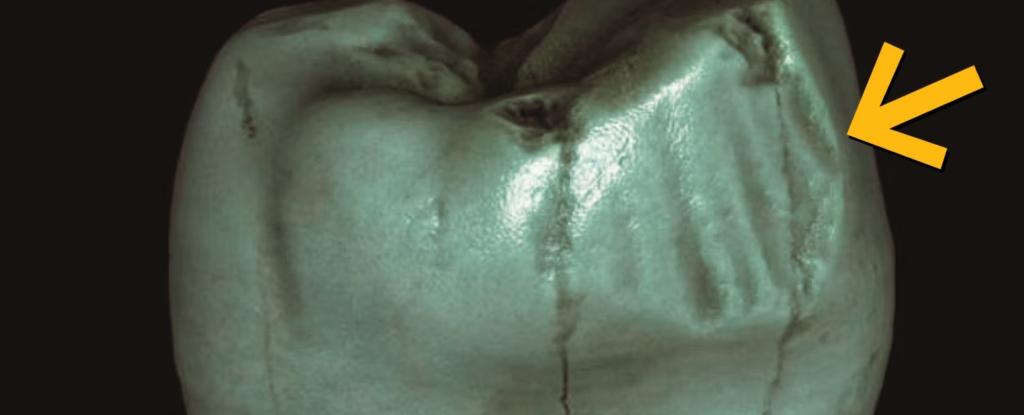
For decades, small grooves on ancient human teeth were believed to be evidence of deliberate tool use—individuals cleaning their teeth with sticks or fibers, or easing gum pain with makeshift “toothpicks.” Some researchers even called it the oldest human habit. However, new findings published in the American Journal of Biological Anthropology challenge this long-held idea about human evolution. Researchers discovered that these grooves also appear naturally in wild primates, with little support for tooth-picking as the cause.
Even more striking, in a study of more than 500 wild primates across 27 species, both living and fossil, researchers found no trace of a common modern dental disease: deep, V-shaped gumline notches known as abfraction lesions. Together, these findings could reshape how we interpret the fossil record and raise fresh questions about the uniquely human ways our teeth are affected today.
Why Teeth Matter in Human Evolution
Teeth are the most durable part of the skeleton and often survive long after the rest of the body has decayed. Anthropologists rely on them to reconstruct ancient diets, lifestyles, and health. Even tiny marks can carry important meaning. One recurring feature is the thin groove across exposed tooth roots, especially between teeth. Since the early 20th century, these have been labeled “toothpick grooves” and interpreted as signs of tool use or dental hygiene.
They have been reported across our recent evolutionary history, from 2-million-year-old fossils through to Neanderthals. But until now, no one had thoroughly investigated whether other primates also have them. A different condition, abfraction, looks very different—deep wedge-shaped notches near the gumline. These are very common in modern dentistry and often linked to tooth grinding, forceful brushing, or acidic drinks. Their absence in the fossil record has long puzzled researchers. Do other primates really never suffer from them?
Research Methodology and Findings
What We Did
To test these assumptions, researchers analyzed more than 500 teeth from 27 primate species, both extinct and living. The sample included gorillas, orangutans, macaques, colobus monkeys, fossil apes, and more. Crucially, all specimens came from wild populations, meaning their tooth wear could not have been influenced by toothbrushes, soft drinks, or processed foods.
Researchers looked for non-carious cervical lesions—a name for tissue loss at the tooth neck not caused by decay. Using microscopes, 3D scans, and tissue-loss measurements, they documented even the smallest lesions.
What We Found
About 4% of individuals had lesions. Some looked almost identical to the classic “toothpick grooves” of fossil humans, complete with fine parallel scratches and tapering shapes. Others were shallow and smooth, especially on front teeth, likely caused by acidic fruits that many primates consume in large amounts.
But one absence stood out. Researchers found no abfraction lesions at all. Despite studying species with extremely tough diets and powerful chewing forces, not a single primate showed the wedge-shaped defects so commonly seen in modern dental clinics.
Implications of the Findings
First, grooves that resemble “toothpick” marks don’t necessarily prove tool use. Natural chewing, abrasive foods, or even swallowed grit can produce similar patterns. In some cases, specialized behaviors like stripping vegetation with the teeth may also contribute. We therefore need to be cautious about interpreting every fossil groove as deliberate toothpicking.
Second, the complete absence of abfraction lesions in primates strongly suggests these are a uniquely human problem, tied to modern habits. They are far more likely to be caused by forceful brushing, acidic drinks, and processed diets than by natural chewing forces.
This places abfraction alongside other dental issues, such as impacted wisdom teeth and misaligned teeth, which are rare in wild primates but common in humans today. Together, these insights are shaping a growing subfield known as evolutionary dentistry, using our evolutionary past to understand the dental problems of the present.
Why It Matters Today
At first glance, grooves on fossil teeth may sound trivial. But they matter for both anthropology and dentistry. For evolutionary science, they show why we must check our closest relatives before assuming a specific, or unique, cultural explanation. For modern health, they highlight how profoundly our diets and lifestyles alter our teeth in ways that set us apart from other primates.
By comparing human teeth with those of other primates, we can tease apart what’s universal (the inevitable wear and tear of chewing) and what’s uniquely human—the result of modern diets, behaviors, and dental care.
What’s Next?
Future research will expand to larger primate samples, investigate diet-wear links in the wild, and apply advanced imaging to see how lesions form. The aim is to refine how we interpret the past while finding new ways to prevent dental disease today. What may look like a fossil human tooth-picking groove could just as easily be the by-product of everyday chewing. Equally, it might reflect other cultural or dietary behaviors that leave similar marks.
To untangle these possibilities, we need much larger comparative datasets of lesions in wild primates; only then can we begin to trace broader patterns and refine our interpretations of the fossil record. Meanwhile, the absence of abfraction lesions in primates suggests that some of our most common dental problems are uniquely human. It’s a reminder that even in something as everyday as toothache, our evolutionary history is written in our teeth, but shaped as much by modern habits as by ancient biology.
Ian Towle, Research Fellow in Biological Anthropology, Monash University, and Luca Fiorenza, Senior Lecturer in Anatomical Sciences, Monash University







